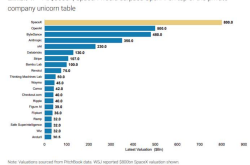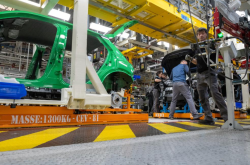Digital Humans Approach Profitability Threshold
![]() 07/17 2025
07/17 2025
![]() 662
662
AI digital humans are poised to become one of the fastest products to complete the business cycle of large models, and they are now nearing the profitability threshold.
"In the summer, a digital human anchor could sell tens of thousands of yuan worth of watermelons in a single day," Song Jian, CTO of DeepBlue AI, told Digital Frontier. "Under the commission-sharing model, both merchants and digital human companies can profit. It's a very promising development."
In the past, large models were criticized for being costly and difficult to commercialize, but AI digital humans might change that. As intelligent agents that resemble humans in appearance and voice, they can engage in dialogue and interaction. They have transitioned from a technology-driven phase to a business validation phase, approaching profitability.
01
Digital Humans Initiate 'Order Urging' in Live Streams
"We no longer distinguish between real people and digital humans," said Song Jian. In the live streaming e-commerce market, the key metric is sales volume, regardless of who is broadcasting.
In fact, the comprehensive labor cost for a mid-level human anchor is typically over 20,000 yuan per month, and their peak live streaming period is up to four hours a day. More critically, for seasonal and low-margin fresh produce, it's challenging for merchants to hire human anchors long-term, and they are reluctant to bear increasing fixed costs.
Digital human anchors can work around the clock, and for products like watermelons, consumers' decision-making process might take just a few seconds. The live stream focuses on showcasing the freshness of the melons. In such cases, digital humans are more efficient than humans for live streaming.
Merchants are embracing digital humans. During this year's "618" shopping festival, JD.com announced that 17,000 brand merchants used digital humans for live streaming sales.
The sales-driving "skills" of digital humans are also improving. Initially, they could only repeat fixed content. Now, they can "understand" Douyin and Taobao backend data and have learned the techniques explored by human anchors. For instance, when the audience exceeds 50 people, the "order urging" strategy kicks in – "I'm about to release a certain number of orders. Please tap '1' on the screen," creating a herd mentality and purchasing pressure, urging users to buy quickly. Digital human anchors are becoming increasingly human-like.
Under these circumstances, some large platforms that previously restricted digital humans are relaxing their regulations and formulating strategies for them, recognizing this as a general trend.
Not only in e-commerce live streaming, Fei Tianqi, Senior Principal Analyst at Gartner, told Digital Frontier that in their 2025 survey of the Chinese AI market, digital humans have become "one of the applications with the highest user activity and industry participation." Digital humans are active in multiple industries such as e-commerce, entertainment, finance, and education.
The core drivers for digital humans to complete the business cycle are the rapid decline in production and operating costs. Industry data shows that the cost of 24-hour live streaming by virtual anchors is already less than one-tenth of that of human anchors.
A senior member of Baidu Intelligent Cloud told Digital Frontier that the core driving force comes from the development of large model technology and application capabilities – the inference cost of large models has dropped by nearly 60 times within a year, multimodal technology has matured, and usability in key scenarios has significantly improved.
From a technical perspective, digital humans have evolved from relying on highly customized motion capture equipment and professional team modeling to today's AI algorithm-driven self-generation. Now, just by uploading a photo and recording a voice, AI can generate a virtual image. For example, Microsoft Xiaoice's 2024 "zero-sample" digital human can complete image and voice replication in seconds with just 30 seconds of image data and 10 seconds of voice data uploaded, supported by large model technologies. From an operational perspective, JD Cloud has announced that the average cost of a Yanxi digital human is less than 100 yuan per day.
This has allowed the application of digital humans to shift from experimental investments to larger-scale industrial deployment. In a case disclosed by Baidu Intelligent Cloud, a catering enterprise used digital humans for a 6-hour live stream at only 15% of the cost of a human anchor, achieving 85% of the sales results of a human anchor.
The education industry is also undergoing a similar transformation. Taking a leading institution as an example, after using digital humans to replace humans in recording courses, the overall production cost was reduced by one-third, and recording efficiency increased by 20 times.
The commercial monetization model for digital humans is also clear. In the B-end market, the mainstream models include SaaS subscriptions, project customization, and revenue sharing.
On the C-end, there are subscriptions and paid digital avatars. Among them, subscription services in the gaming sector have been accepted, but monthly payments for cloned digital humans have not yet formed large-scale consumption habits in China.
However, despite the rapid popularization of AI digital human technology, market growth is showing linear rather than exponential growth. The IDC report predicts that the compound annual growth rate of digital humans will be 43.5% from 2024 to 2029, and the market size will reach 25.05 billion yuan by 2029. "This growth belongs to steady growth in the internet industry," a relevant person from Silicon Intelligence told Digital Frontier.
"It can be seen as a phased application 'explosion,'" said Xu Yuanchun, CEO of Microsoft Xiaoice. On the one hand, it's due to the decline in the application cost of digital humans; on the other hand, it's because the scenario validation of large KA customers has entered deep waters, requiring a longer cycle for exploration and breakthrough. He believes that when digital human technology can simultaneously meet the triple goals of anthropomorphic interaction, scenario-based value, and low-cost operation and maintenance, it will usher in exponential growth in market size.
02
Industries with the Greatest Need are the First to Adopt
Which industries are the first to form a business cycle for digital humans?
According to data from the iMedia Consulting 2025 report, e-commerce, health, social security, education, and finance are currently the most concentrated areas for digital human enterprises. This distribution is not coincidental but corresponds to industries with highly similar elements: continuous demand for interactive experiences, standardized scenario structures, and solid digital foundations.
In short, industries with the greatest need are the first to adopt the technology. Wherever there are cost pressures and service gaps, digital humans have taken the lead in finding entry points.
A member of Baidu Intelligent Cloud told Digital Frontier that digital employees based on service and marketing scenarios naturally have the advantages of "measurable value and high closed-loop efficiency." Digital humans have scaled up in high-tolerance scenarios such as e-commerce live streaming and basic customer service.
More than half of Silicon Intelligence's business comes from the pan-government market, especially government service halls, where there are high demands from various commissions, offices, and bureaus. Governments generally procure complete solutions and require out-of-the-box products.
"The core of the implementation of such digital humans is closely related to the highlights of the project," analyzed a government project supplier. "Digital humans have clear display effects and demonstration effects, and can also enhance the sense of interaction. The usage rate of citizens is also high in business processing such as provident funds and social security."
The National Medical Products Administration once showcased its "AI Medication Consultant" at the "Digital China" event in Fujian. This digital human, created in collaboration with China Telecom, can provide basic medication answers around the clock. Compared with traditional static Q&A terminals, digital humans can handle multiple rounds of inquiries, with facial expressions and natural tones, reducing citizens' resistance to technical systems.
Song Jian of DeepBlue AI further observed that digital humans in public places such as service halls will also undergo an upgrade. They can judge emotions through the other party's appearance, movements, and tone changes, thereby making warm responses. Behind this is the increasingly close integration of digital humans with large models, environmental perception, and other systems, acquiring the "sensibility" of real humans, evolving from "rote recitation" by a single person to multi-person interaction.
"Large models are also deeply integrated with industry knowledge, extending to 'low-tolerance, highly specialized' scenarios such as industry services and industry marketing," emphasized a relevant person from Baidu Intelligent Cloud, highlighting another major trend in the market this year.
For example, in auto telemarketing digital employees, when users inquire, they must not only insight into customer needs and provide flexible responses but also give accurate responses based on the actual parameters of the automaker to support user decisions. This requires deeply refining the vertical decision-making chain and creating out-of-the-box solutions to deliver quantifiable business results and form a gradual penetration curve. The precipitation and systematic encapsulation of vertical scenario Know-how are the competitive thresholds.
A person from Silicon Intelligence had a similar observation. Digital human enterprises are entering vertical industries. This year, the landing application that impressed her the most was a large hospital launching digital human doctors. Previously, when patients entered the hospital, they couldn't say much to the doctor before leaving. Now, based on reports, doctor's advice, and large model analysis, digital human doctors can go over the information in detail and respond to patients' rehabilitation guidance and health questions, immediately enhancing the patient experience.
"AI Interviewers" is another application direction with extremely fast landing speeds, especially in the fields of civil service, campus recruitment, vocational ability testing, and training. Digital humans are becoming low-cost, high-intensity substitutes for training. Another extension of educational scenarios is "digital tutors" or "digital teaching assistants." In its strategies and actions, Baidu clearly identifies college admission consultants, 4S store sales specialists, and bank marketing specialists as key expansion directions, planning to create dedicated models and connect "industry smart agents" with systems such as education SaaS and automotive CRM.
Similar examples include digital human lawyers, which lower the threshold. A person from Silicon Intelligence believes that this is a good way to achieve technological equality.
Gaming is another promising direction. "In the past, NPCs (non-player characters) in games were driven by fixed scripts," analyzed Song Jian. "Now, digital humans can become characters with ideas." In future games, the relationship between players and NPCs can be "relationship-developing." This is a qualitative leap in immersive experience and opens up new horizons for game design.
In these scenarios, digital humans are no longer just tools but gradually acquire "role attributes."
However, some demands are considered pseudo-demands by the industry, such as digital humans in the exhibition halls of some companies. "Unless it's a large company, the utilization rate is very low. Many of these digital humans are rented on a monthly basis. Ultimately, some companies abandoned paying for them," observed an insider.
03
Hundreds of Thousands of Digital Human Enterprises? The Technology and Divisions Behind Them
Behind the explosion of digital human applications, the deeper logic is the breakthrough in the technical capabilities of large models.
"The so-called explosion is not the explosion of digital humans themselves, but rather relies on the explosion of the entire large model ecosystem," said a person from Silicon Intelligence. In early 2024, the breakthrough in cost and performance of large models represented by DeepSeek improved the effectiveness of digital humans and significantly reduced the threshold for implementation.
In fact, digital humans have existed for a long time and entered the public eye around 2020 when the concept of the metaverse emerged. However, it was not until after 2022, when large model technology rapidly matured, that it truly enabled the progression from "looking like humans" to "interacting like humans."
Behind this, large models have greatly enhanced digital humans. Previously, creating a high-quality digital human was synonymous with "high-end customization." Now, through AI-driven image modeling, speech synthesis, and other technologies, the generation of digital humans has entered the "inclusive" stage.
Song Jian, CTO of DeepBlue AI, gave an example. During this year's "618" shopping festival, the digital human versions of Luo Yonghao and his partner He Xiaomu presented a real, natural, and well-coordinated "daily interaction mode" in a live stream on the Baidu platform. The digital humans could also capture live comments in real time and perform semantic analysis, responding to audience questions in the style of "Luo's humor," with an interaction effect approaching that of a human live stream.
"When users' sense of immersion approaches reality, their psychological defenses against AI basically disappear," said Song Jian.
However, enterprises generally believe that the next big challenge for digital humans is to make their "brains" smarter.
With promising prospects in the technology and business market, data from ITJuzi reveals that as of July 7, there have been 23 investment and financing cases in the digital human field in 2025, nearing the total of 24 cases recorded for the entire year of 2024. The average financing amount surpasses 150 million yuan, signaling an acceleration in the "technology-market-capital" drive.
Market competition is intensifying. A representative from Silicon Intelligence stated, "Digital humans are perceived as a highly profitable and promising industry with relatively low barriers to entry, attracting a surge of enterprises into the field."
The third issue of the "China Virtual Digital Human Influence Index Report" indicates that in 2023, there were over 993,000 enterprises related to "digital humans and virtual humans," with more than 400,000 newly added, marking a 42.3% year-on-year increase. However, according to Qichacha data as of July 7, the number of existing domestic enterprises related to digital humans and virtual humans stands at 2,492. Since the beginning of 2023, a total of 228 related enterprises have been registered, with 139 registered in 2023 alone, accounting for 61%.
Despite various claims ranging from hundreds of thousands to thousands, few companies truly possess the comprehensive technical capabilities spanning from modeling to interaction to decision-making. Enterprises are rapidly differentiating themselves through technological barriers.
Xu Yuanchun, CEO of Microsoft Xiaoice, acknowledged, "It will be challenging to establish a competitive edge based on a single dimension in the future." The truly competitive players are full-stack companies that possess 2D/3D digital human modeling and driving rendering, speech recognition and synthesis, dialogue capabilities, large model and AIGC capabilities, and can deeply integrate technology into vertical scenarios.
In addition to the full-stack approach emphasized by Microsoft Xiaoice, the current supplier landscape in the market is diverse: on one side are "big factories" like Baidu, ByteDance, Alibaba, Huawei Cloud, and JD Technology, offering digital human underlying capabilities, platforms, and solutions; on the other side are independent companies such as DeepBlue AI and Silicon Intelligence, deeply rooted in vertical industries and providing customized delivery and operational support.
However, unlike domestic enterprises that require multiple "skills" or even a full stack, overseas digital human enterprises tend to collaborate through specialization and division of labor.
As Song Jian noted, "Large factories excel in software tools, platform support, and standard solutions, while independent companies like ours delve into the real scenarios of industry customers, providing customization, optimization, and detailed operational services." For instance, in the live streaming e-commerce market, payment is performance-based, necessitating a review of the market and live stream to adjust the video or product angles, requiring detailed human operational services.
A significant trend underway is the evolution of digital humans from mere "virtual images" to "business intelligent agents." A member of Baidu Intelligent Cloud suggested that in the future, digital humans will become prevalent due to their low cost and personalization, serving as "expressers," while digital employees will act as "decision-makers and executors." The former addresses the issue of "how to perform," while the latter is responsible for "how to do things." Digital employees integrate anthropomorphic images with business decision-making capabilities, representing a logical extension of digital humans and the next phase of their commercialization.






